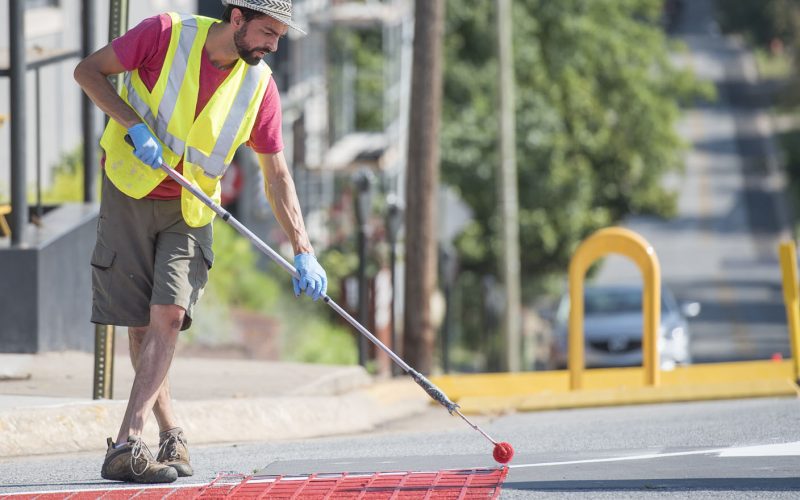STACY RYBURN
sryburn@nwadg.com
NWA Democrat-Gazette/J.T. WAMPLER Michael EWard of Fayetteville works Sunday July 23, 2017 at painting new crosswalk and curb extensions at the Church Ave. intersection with Center St. Fayetteville has officially launched its Tactical Urbanism program where residents can put together a plan to build a crosswalk or bike lane or decorative plants or nonpermanent road barrier of some kind and submit it to the city.
Residents who want to take care of their neighborhood’s immediate concerns, such as safely crossing the street, slowing down cars or creating bicycle lanes, now can do so on their own with city approval.
The city rolled out its tactical urbanism program last week. The practice entails using low-cost, temporary materials to create traffic safety features or decoration.
The term is largely attributed to urban planner Mike Lydon, whose Street Plans Collaborative held a workshop on the topic for city officials in November. Several volunteers put together a crosswalk and bike lane in front of Nadine Baum Studios, crossing from the trail to West Avenue, during the workshop.
In January, volunteers replaced the four-way stop at Spring Street and School Avenue with a roundabout that was removed in March. City staff concluded the roundabout eased traffic for bicyclists traveling between the Razorback Greenway and downtown. However, motorists generally failed to yield, creating potentially unsafe situations with pedestrians.
The latest approved project placed crosswalks and curb extensions to Center Street and Church Avenue in front of Arsaga’s. Michael Ward, a developer, says he walks across the intersection regularly and has noticed problems for pedestrians. The project is scheduled to stay there until fall.
NWA Democrat-Gazette/J.T. WAMPLER Volunteers work Sunday July 23, 2017 at painting new crosswalk and curb extensions at the Church Ave. intersection with Center St. Fayetteville has officially launched its Tactical Urbanism program where residents can put together a plan to build a crosswalk or bike lane or decorative plants or nonpermanent road barrier of some kind and submit it to the city.
“There are no crosswalks there. There are wide lanes and a big turning radius for cars,” he says. “Cars tend to roll through the intersection. Sometimes they stop, and sometimes they don’t. It’s unclear who really should be walking and who should be driving.”
The city started beta testing the program after getting a handful of inquiries following the November workshop, says Chris Brown, city engineer. Ward’s project was born from that test phase.
Another approved project will put crosswalks and an extended curb in front of the Yvonne Richardson Community Center at Mill Avenue and Rock Street. The varied traffic pattern of having a yield sign facing west on Rock Street, no sign on Mill Avenue and a stop sign facing east on Rock Street eventually will be replaced with stop signs going all three ways, according to Sam Slaton with BikeNWA.
Community Center summer campers will help design the crosswalks. A curb extension on the west side of Mill Avenue and Rock Street will reduce a 55-foot turning radius to 20 feet, slowing down cars as they move. Volunteers also have asked for a sidewalk on the north side of Rock Street leading to the center.
The crosswalks, curb extension and stop signs will be installed the morning of Aug. 11.
A project has to meet certain criteria to gain approval. Nothing can go on a state highway. Putting paint on a major street or public right of way is iffy. Enough room has to be left for emergency vehicles to maneuver. Residents make their own schedules and have to buy their own materials. An online guide suggests materials, ranging from hand-painted signs to hay bales.
City employees in engineering, transportation and parking, along with police and firefighters, all will put eyes on a more involved proposal before its approval or denial, Brown says. Simple works like painting the street or a sign likely will get quick approval.
Once the project is installed and its approved time frame ends, three outcomes are possible. It may turn out the idea didn’t really work and it won’t return. Or, if it’s a simple job, the residents can keep it going with regular maintenance. Lastly, if the project succeeds and garners positive feedback, it may make the city’s work list and re-emerge with permanent materials.
“It’s a good way to test out things that may seem a little out there,” Brown says. “But, if they work, and they don’t cause a problem, maybe we’ll implement them.”





